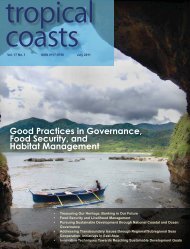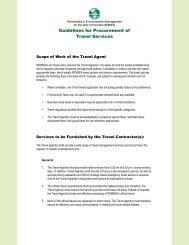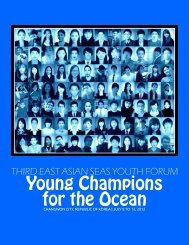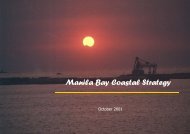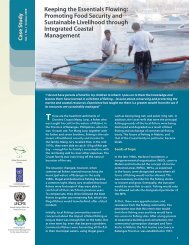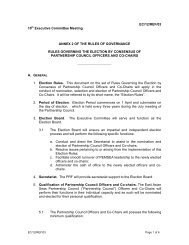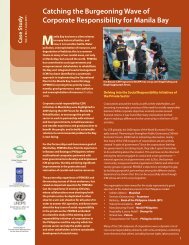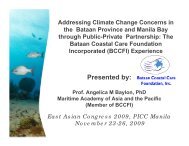Download PDF Copy - Pemsea
Download PDF Copy - Pemsea
Download PDF Copy - Pemsea
Create successful ePaper yourself
Turn your PDF publications into a flip-book with our unique Google optimized e-Paper software.
S U S T A I N A B L E D E V E L O P M E N T A S P E C T S<br />
Water quality monitoring is useful in determining sustainability of different areas of<br />
the coast for various uses such as for recreation and aquaculture. The water quality<br />
monitoring program of PG-ENRO covers Batangas Bay and Pansipit River.<br />
Implications and Recommendations<br />
A more strategic approach to monitoring of coastal and river<br />
waters may be developed by considering water use in the<br />
different areas of the coast (e.g., swimming/beach area;<br />
navigation/port; fishing/aquaculture; habitat/spawning; etc.)<br />
and the water quality prescribed for that particular use/<br />
season. Environmental risk assessment is a useful tool for<br />
identifying priority locations and parameters for monitoring<br />
programs, as well as for interpreting results and evaluating<br />
risks to society, the economy and the environment.<br />
An upward trend in coliform contamination of river waters<br />
is evident, and this implies a potential concern regarding<br />
improved management of domestic sewage and livestock<br />
wastes. Municipal LGUs and concerned agencies must<br />
strictly enforce regulations on pollution and waste discharges.<br />
be considered. The monitoring of “hotspot” rivers such as<br />
Calumpang River, as well as assessment of groundwater<br />
quality, would be relevant to the protection of potable water<br />
supplies.<br />
It may also be useful for PG-ENRO to partner with the EMB-<br />
DENR and local industries for water quality monitoring. This<br />
would result in more efficient use of available resources and<br />
information could be shared on a province-wide manner.<br />
Also, a more systematic approach to reporting water quality<br />
results would benefit all providers of monitoring data,<br />
decision-makers and stakeholders. This could probably<br />
be handled at the provincial level, where water quality<br />
monitoring results from various sectors could be properly<br />
collated, analyzed and disseminated.<br />
Pollution and Waste Management<br />
Water quality<br />
Expanding the monitoring area for marine water quality in<br />
Batangas Bay to cover Lobo, as well as Tayabas Bay, can<br />
References<br />
Batangas Environment Laboratory. 2007-2008. Water Quality Monitoring of Balayan.<br />
Batangas Environment Laboratory. 1997-2007. Quarterly Monitoring Report for Batangas Bay.<br />
Batangas Environment Laboratory. 2002-2007. Quarterly Monitoring Report for Pansipit River.<br />
DAO 34 (DENR Administrative Order No. 34). 1990. Revised Water Usage and Classification (Water Quality Criteria<br />
Amending Section Nos. 68 and 69, Chapter III of the 1978 NPCC Rules and Regulations). Environmental<br />
Management Bureau, Department of Environment and Natural Resources, Quezon City, Philippines.<br />
Jusoh, M.M., K.S. Ong, G.A. Vigers, I.M. Watson and C.A. McPherson. 1999. “A Contextual Framework for the<br />
Development and Use of Marine Water Quality Criteria in ASEAN.” In: McPherson, C.A., P.M. Chapman, G.A.<br />
Vigers and K.S.Ong (eds.). ASEAN Marine Water Quality Criteria: Contextual Framework, Principles, Methodology<br />
and Criteria for 18 Parameters. ASEAN Marine Environmental Quality Criteria - Working Group (AMEQC-WG),<br />
ASEAN-Canada Cooperative Programme on Marine Science - Phase II (CPMS-II). EVS Environment Consultants,<br />
North Vancouver and Department of Fisheries, Malaysia. pp. I-1 to I-10.<br />
State of the Coasts of Batangas Province<br />
101



